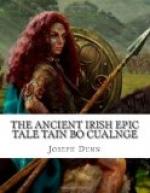[1-1] LU. and YBL. 1496-1497.
[2-2] Stowe.
[3-3] Stowe.
[4-4] LU. and YBL. 1499-1500.
[5]There they passed the night.[5] Then early on the morrow morn arose Cur macDa Loth [6]and he came to the ford of battle and combat; and however early he arose, earlier still Cuchulain arose.[6] A cart-load of arms was taken along with him wherewith to engage with Cuchulain, and he began to ply his weapons, seeking to kill Cuchulain.
[5-5] Eg. 93.
[6-6] Eg. 93.
Now Cuchulain had gone early that day [7]to practise[7] his feats [8]of valour and prowess.[8] These are the names of them all: the Apple-feat, and the Edge-feat, and the Level Shield-feat, and the Little Dart-feat, and the Rope-feat, and the Body-feat, and the Feat of Catt, and the Hero’s Salmon-leap,[a] and the Pole-cast, and the Leap over a Blow (?), and the Folding of a noble Chariot-fighter, and the Gae Bulga (’the Barbed Spear’) and the Vantage (?) of Swiftness, and the Wheel-feat, [9]and the Rim-feat,[9] and the Over-Breath-feat, and the Breaking of a Sword, and the Champion’s Cry, and the Measured Stroke, and the Side Stroke, and the Running up a Lance and standing erect on its Point, and the Binding of the [10]noble[10] Hero (around spear points).
[7-7] LU. and YBL. 1500.
[8-8] Stowe.
[a] “The Salmon-leap—lying
flat on his face and then springing up,
horizontally, high in the
air.”—J.A. Synge, “The
Aran Islands,” page
111, Dublin, 1907.
[9-9] YBL. 1504.
[10-10] LU. 1506.
[W.2121.] Now this is the reason Cuchulain was wont to practise early every morning each of those feats [1]with the agility of a single hand, as best a wild-cat may,[1] in order that they might not depart from him through forgetfulness or lack of remembrance.
[1-1] An obscure gloss in LL.
And macDa Loth waited beside his shield until the third part of the day, [2]plying his weapons,[2] seeking the chance to kill Cuchulain; [3]and not the stroke of a blow reached Cuchulain, because of the intensity of his feats, nor was he aware that a warrior was thrusting at him.[3] It was then Laeg[a] [4]looked at him[4] and spake to Cuchulain, “Hark! Cucuc. Attend to the warrior that seeks to kill thee.” Then it was that Cuchulain glanced at him and then it was that he raised and threw the eight apples on high [5]and cast the ninth apple[5] a throw’s length from him at Cur macDa Loth, so that it struck on the disk of his shield [6]between the edge and the body of the shield[6] and on the forehead [7]of the churl,[7] so that it carried the size of an apple of his brains out through the back of his head. Thus fell Cur macDa Loth also at the hand of Cuchulain. [8]According to another version[8] [9]it was in Imslige Glendamnach that Cur fell.[9]
[2-2] LU. and YBL. 1507.




